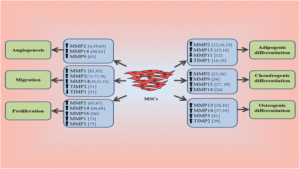Some supplements affect MMP expression. Zinc suppresses MMP2 and MMP9(Zinc Regulates Lipid Metabolism and MMPs Expression in Lipid Disturbance Rabbits.) and Selenium decreases MMP2 and TIMP1 levels(Selenium’s effects on MMP-2 and TIMP-1 secretion by human trabecular meshwork cells).
Effects of matrix metalloproteinases on the fate of mesenchymal stem cells.
“Mesenchymal stem cells (MSCs) have great potential as a source of cells for cell-based therapy because of their ability for self-renewal and differentiation into functional cells. Moreover, matrix metalloproteinases (MMPs) have a critical role in the differentiation of MSCs into different lineages. MSCs also interact with exogenous MMPs at their surface, and regulate the pericellular localization of MMP activities{so you could supplement with exogenous(external from the body) MMPs to manipulate MSC and hopefully induce chondrogesis}. The fate of MSCs is regulated by specific MMPs associated with a key cell lineage. Recent reports suggest the integration of MMPs in the differentiation, angiogenesis, proliferation, and migration of MSCs{all these four things are likely factors related to chondroinduction}. These interactions are not fully understood and warrant further investigation, especially for their application as therapeutic tools to treat different diseases. Therefore, overexpression of a single MMP or tissue-specific inhibitor of metalloproteinase in MSCs may promote transdifferentiation into a specific cell lineage{this could help you grow taller if it’s transdifferentiation towards a chondrogenic lineage the official term for neo growth plate formation would be something like interosseous chondrofication}, which can be used for the treatment of some diseases. In this review, we critically discuss the identification of various MMPs and the signaling pathways that affect the differentiation, migration, angiogenesis, and proliferation of MSCs.”
“Collagenases (MMP-1, MMP-8, MMP-13, and MMP-18) cleave fibrillar collagen types I, II, and III, and they can cleave other ECM proteins. Gelatinases (MMP-2 and MMP-9) have high activity against gelatin, and degrade other ECM molecules including collagens, laminin, and aggrecan. Stromelysins (MMP-3, MMP-10, and MMP-11) digest a number of noncollagen ECM molecules, and their domain arrangement is similar to that of collagenases. The membrane-type MMPs (MT-MMPs) (MMP-14, MMP-15, MMP-16, MMP-17, MMP-24, and MMP-25) are intracellularly activated transmembrane molecules, and their active forms are expressed on the cell surface. There are other less characterized members including MMP-7, MMP-12, MMP-19, MMP-20, MMP-22, and MMP-23”
“MMPs have critical role in the differentiation of MSCs to adipocytes, osteocytes, and chondrocytes. MSCs interact with exogenous MMPs at their surface and activate proMMP-2 and proMMP-13, regulating the pericellular localization of MMP activities. They have the capability to regulate exogenous MMP-2 and MMP-9 by the expression of TIMP-2 and TIMP-1, protecting the perivascular niche from their high levels”
“silencing of MMP-2 by siRNA impaired chondrogenic differentiation, and increased the protein level of fibronectin and β1 integrin. Treatment with a MMP-2 activator resulted in the activation of chondrogenesis. ”
“MMP-2 is involved in the chondrogenic differentiation of MSCs via downregulation of focal adhesion kinase (FAK)–β1 integrin interaction, which leads to phosphorylation of FAK”
“the degradation of MMPs enhances the chondrogenic differentiation of MSCs by allowing the morphological changes and increasing the contents of glycosaminoglycans (GAG) and expression of chondrogenic markers. A chondrogenic cell line (ATDC5) was examined for chondrogenic differentiation, and the expression of MMP-2, MMP-9, and MT1-MMP was upregulated during the early stages of chondrogenic differentiation with a downregulation in the expression of reversion-inducing cysteine-rich protein with Kazal motifs (RECK)”
“t the increase in production of MMP-13 drives the MSC differentiation to chondrocytes by degrading the cleavable components of the ECM, and regulating integrin-binding peptides”
“Stimulation of MSCs in chondrogenic media with IL-β1 resulted in increased expression of MMP-2, MMP-3, and MMP-13 while IL-6 downregulated the expression of MMP-3 and MMP-13 compared with control without stimulation”
” Commitment of MSCs to differentiate into a specific lineage, proliferate, or migrate is regulated by many factors in the local tissue microenvironment.”<-So finding a way to stimulate MMP2 on it’s own may not be enough on it’s own to create chondroinduction.

